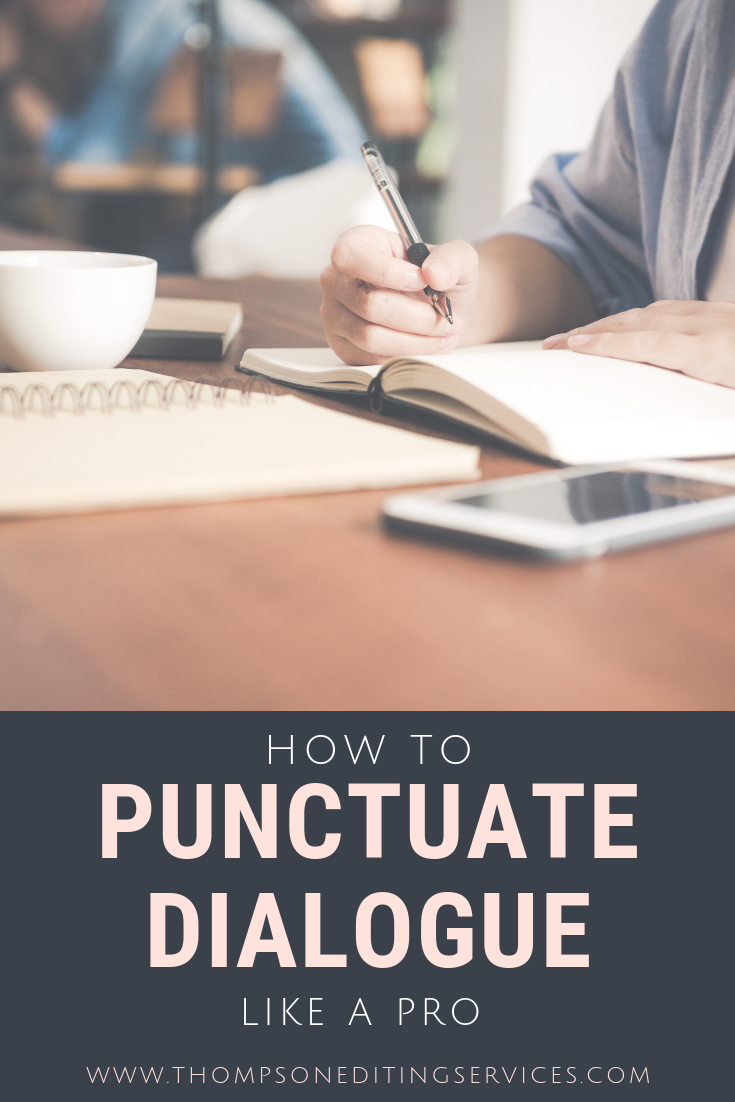How to Punctuate Dialogue Like a Pro
Punctuating dialogue can be a big task. There are so many different situations to figure out. Do you use a comma or a period at the end of dialogue? And does a quesiton mark go inside or outside of the quotation marks?
If you're like me, you've asked yourself these questions all the time. It probably seems like every time you sit down to write, you have to stop and figure out how to punctuation at least one line of dialogue. It's frustating and takes up too much time.
But once I learned the ins and outs of punctuating dialogue, my writing and editing time got a lot shorter.
You can use this guide as a learning tool to read through and study or as a quick reference when you find yourself wondering about a specific senerio while editing.
1. Punctuation that goes inside quotation marks
Commas and periods always go inside quotation marks whether you're punctuating dialogue or quotes. If the dialogue ends the sentence, it gets a period, and if the dialogue ends in the middle of the sentence, it gets a comma.
Example 1: Whenever I did something clumsy like my father would, my mom liked to say, "The apple doesn't fall far from the tree."
Example 2: "When I was a little girl," said Sarah, "I climbed trees all the time."
2. Punctuation that goes outside quotation marks
Colons and semicolons always fall outside of quotation marks if it comes at the end of the dialogue or quote. The only time either would fall inside the dialogue is if either splits a sentence like in example 2.
Example 1: I didn't understand what they meant when they said, "The grass is always greener on the other side"; now that I'm on the other side, I finally see it isn't everything I thought it would be.
Example 2: "He likes only three things: hunting, biking, and rock climbing."
3. How to punctuate with dialogue tags
Dialogue tags are the "he said" and "she asked" that follow a line of dialogue to let the reader know who is speaking. Whenever a dialogue tag follows, the dialogue must end with a comma. I've seen many authors end dialogue with a period before a tag. However, the dialogue tag is part of the sentence, and you wouldn't put a period in the middle of a sentence.
When dialogue or a quote ends with a question mark, the following dialogue tag must be lowercase. This again goes back to the fact that the dialogue tag is part of the sentence, not a new sentence.
Note: Actions like "laugh," "smile," and "frown" do not count as dialogue tags but as action tags. See below for more information about action tags.
Example 1: "You will never understand why I'm on the waves every day. Not until you feel the rush of the wind and waves at your back," said Jake.
Example 2: "How could I when you never give me the chance?" asked Katie.
4. How to punctuate with no dialogue tags
This is perhaps the easiest situation to punctuate. All punctuation at the end of dialogue without tags goes inside the quotation marks.
Example 1: "Where have you been? It's two in the morning!"
Example 2: "I can't understand why he would do that."
5. How to punctuate interrupted dialogue
Interruptions can occur during arguements or regular conversation. When this happens, use an em-dash with no space on either side to indicate that there was more to say but the character was cut short.
Many word processors will automatically change two hyphens into an em-dash, or you can insert an em-dash under the "advanced symbol" section of some word processors.
Example 1: "Why are we sneaking—"
"Shhh!"
6. How to punctuate unfinished dialogue
When we talk, sometimes we forget our train of thought, we decide not to say any more, or we just trail off. When your characters to that, a ellipsis follows the dialogue and preceeds the quotation mark as seen in example 1. If there is a pause in dialogue or you're trying to replicate heavy breathing, an ellipsis can be used as well, like in example 2.
Example 1: "She didn't tell me anything. She only..." Virgina paused. She wasn't supposed to mention that.
Example 2: "I ran...from the store...as fast as...I could..." Ashley said between gasps for breath.
7. How to punctuate dialogue that spans more than one paragraph
While it's generally best not to let one character control the spotlight for a long monologue, it is sometimes necessary for one character to say a lot.
When you have to break a character's dialogue into multiple paragraphs without anyone interrupting him or her, leave the quotation off the end of the first paragraph and add one at the start of the second paragraph. When the character is finished speaking, remember to close it with a final quotation mark.
Example 1: "When I came here, I was afraid people would figure out where I came from. Who I was. I knew that my uncle had been killed when they learned about him, and I was so scared.
"The Lockwoods found me, and I...I lied to them. I was only six, and I had no one. I had to do something."
Want to learn more punctuation tips?
Get your copy of The Author’s Guide to Spelling, Grammar, & Punctuation for just $7!
Learn the most common writing mistakes in spelling, grammar, punctuation, style, and word choice.
Learn how to make these edits to save you money on professional editing
Learn the 1 tool that will change the way you edit your book.
Meagan Thompson created ThompsonEditingServices.com to teach authors how to become better editors of their books. She also provides professional editing and formatting services.
When she isn’t editing or writing, Meagan enjoys watching movies with her husband, sharing meals and playing games with family and friends, listening to jazz music, and dreaming about her next travel destination.




